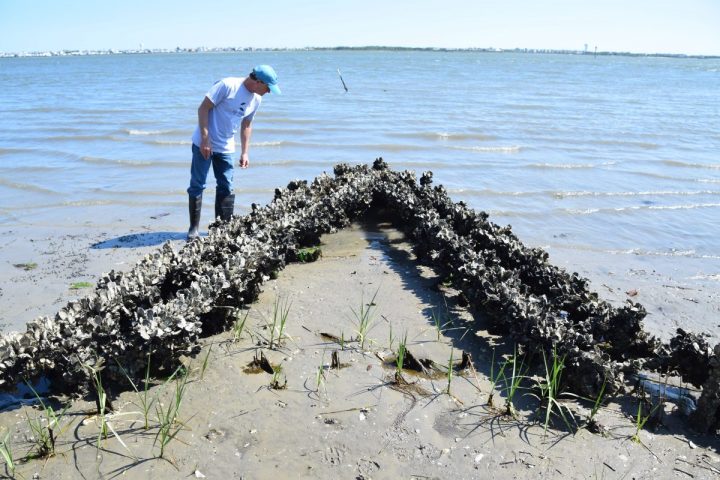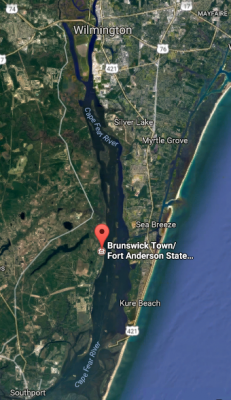
MOREHEAD CITY – A new design of artificial oyster reef-maker could buck the trend on where living shorelines best work.
Researchers at the University of North Carolina at Chapel Hill’s Institute of Marine Sciences, or IMS, are introducing a type of reef that may withstand high-energy wave action areas typically deemed unsuitable for natural shoreline stabilization.
Supporter Spotlight
Living shoreline projects are built with various structural and organic materials such as plants, submerged aquatic vegetation, oyster shells and stone. They generally work best along sheltered coasts such as estuaries, bays, lagoons and coastal deltas, where wave energy is low to moderate.
This month, researchers will put to the test a series of reef platforms that are going to be installed as part of what is, to date, the longest state-permitted living shoreline project in North Carolina.
The Brunswick Town/Fort Anderson State Historic Site’s battered mile-long shore along the Cape Fear River will be a significant test on how well the oyster reefs hold up in a high-energy wave environment.
“One thing we have, I think, the ability to do with our new material is really get into high-energy environments and do quite well,” said Niels Lindquist, an IMS professor and researcher.

Construction will begin this month along about a 100-foot section of the historic site’s waterfront, where contractors will install about 200 feet of artificial oyster reef-makers.
Supporter Spotlight
The reefs are constructed of concrete smoothed into panels that are used to create different forms and shapes, the end result of which is a netted, open structure.
These platform structures will be fastened to rods anchored in the sediment, elevating the reef slightly above the riverbed.
“We tend to see sediment buildup in and behind our reefs,” Lindquist said. “We get some very high oyster densities so we get a lot of the good services from oysters. I think if we can really get into that area and grow a good oyster reef there will be a lot of benefits.”
These reefs will be placed between the shore and a series of wave attenuators, which will take the initial brunt of waves created during storms and the large cargo ships routinely sailing to and from the North Carolina Port of Wilmington.
For the better part of 10 years, officials at the historic site have been trying to figure out how to best combat shoreline erosion, which has damaged and destroyed irreplaceable artifacts.
“We’ve done a few stop-gap measures that have bought us time, but we have run out of time,” said Jim McKee, Fort Anderson’s site manager.
McKee prefers a living shoreline to a hardened erosion-control structure because the former is not only more aesthetically pleasing, he said, but also a natural method of protecting valuable resources.
“We’re revisiting the underwater cultural resources surveys and, as it stands, we have an opportunity to lessen the impact on those cultural resources and we’ll definitely lessen the impact on our environmental resources,” McKee said. “What we’re proposing is a very, very aggressive project and the scope is massive. I don’t think something on this scale has been attempted in North Carolina and I don’t know if it’s been attempted anywhere else.”
Designed by a team of experts with environmental engineering firm SEPI Engineering, which has an office in Wilmington, the massive project will be completed in various phases.
The first phase, construction of which McKee said he hopes will begin this week, concentrates on section of shoreline devastated by Hurricane Matthew, which hit North Carolina last October, causing massive flooding throughout southeastern parts of the state.
The storm cut out about a 14- to 15-foot gap, causing a bluff to collapse, sending trees sliding from where they had been rooted for years.
This section will be filled, the bluff restored and armored with riprap. Once that’s complete, the reef-makers will be installed.
“It should break up a lot of that heavy action and start allowing that section of shoreline to start renewing itself,” McKee said. “Then we’ll be able to start monitoring.”
There has been better than a 50-percent survival rate of oysters placed on a small pad researchers installed for monitoring purposes, he said.
Oysters were showing promise growing on the riprap shredded away during Hurricane Matthew, McKee said.
“If we can break down that wave action then the oysters should establish themselves,” he said.

That’s the hope, Lindquist said.
“I’m hopeful that we can get into that area and have our material grow and survive oysters,” he said. “Our goal with our material is to really stop shoreline erosion but to also regrow some of the marsh. It’s a pretty substantial plan, but I think we can handle it.”
The project has been drawing interest from the likes of everyone from environmental engineers, researchers, coastal scientists and state officials, McKee said.
If the oyster-maker platforms perform well in such a high-energy wave environment, they could help broaden the use of living shoreline projects as erosion-control methods.
In the past several years, living shorelines have been gaining national attention.
Just this year, the Army Corps of Engineers authorized its first nationwide permit for living shorelines.
The new permit is designed to help streamline the permitting process. Living shoreline advocates hope that translates into a tipping of the scales where requests for permits to build living shoreline projects outweigh hardened erosion-control methods.
At least 14 percent of the country’s shoreline is armored by hardened structures, according to the first nationwide survey of artificial coastal erosion-control methods conducted by a group of researchers in 2015.
That’s more than 14,000 miles of hardened shoreline.
One of the benefits the oyster reef platforms offer is that they’re made of biodegradable materials.
“That has some advantages because if you make a mistake and you don’t really grow oysters you’re not left with this legacy of material there that you don’t want,” Lindquist said.
Lindquist said the oyster reef-makers are gaining traction, drawing the attention of researchers in Florida and Washington.
He said researchers have applied for a patent for the name, materials and applications used to make the reef-makers. Their goal is to commercialize the technology.
They are currently looking into the possibility of adapting their design to “bio-cement,” or cement created using bacteria between grains of aggregate – a brainchild of the Raleigh-based start-up company bioMason.
“If we really can do that then our material will be entirely green,” Lindquist said. “I think manufacturing a situation where we’re sequestering CO2 and then use that material to prevent the erosion of salt marshes and then regrow them is great for the environment.”









